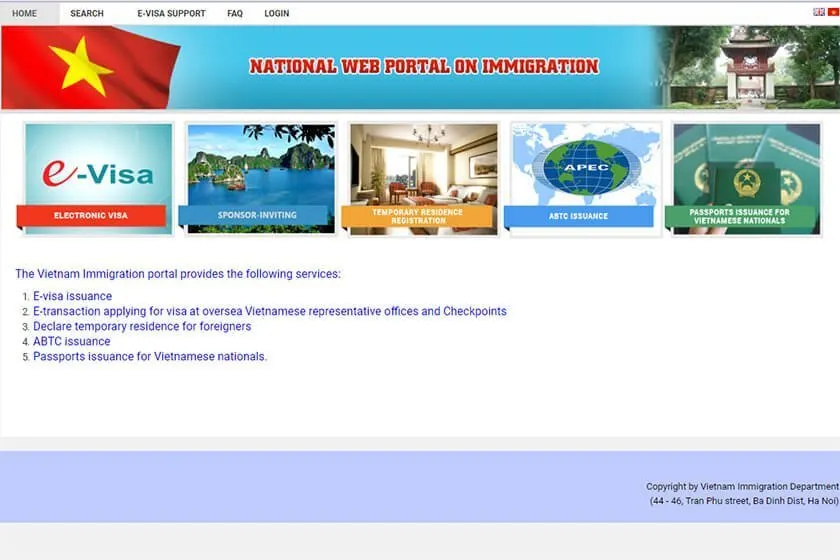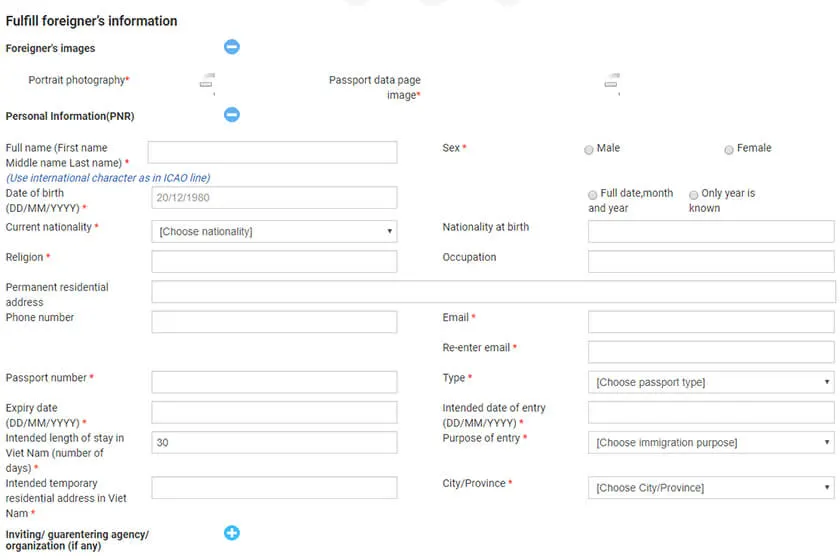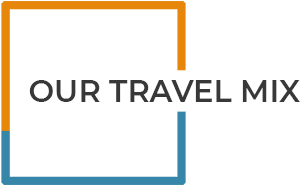The first time we visited Vietnam our biggest question was “do you need a visa for Vietnam?”
We spent hours searching for the right answer, and we did learn one thing: everyone else is asking the same question.
So we decided to write a definitive guide to answer first, whether you need a visa to visit Vietnam, and second, how you should attain one.
We can simplify the entire process into 4 options:
- Your country doesn’t require a visa to visit Vietnam
- Your country qualifies for an online Vietnam eVisa
- You can purchase a Vietnam Visa on Arrival (VOA)
- Purchase a Visa from your local Vietnam Embassy (most expensive option)
Read on to find out which option is right for you.
Vietnam Visa Exemptions
Fortunately, there is a list of countries which are exempt from requiring a visa to visit Vietnam. If you are a citizen of any of these countries, you can freely enter and exit Vietnam without attaining a visa.
We still recommend double-checking with your local Vietnam embassy (just give them a call) as visa requirements can change often.
List of Countries Exempt From Vietnam Visa Requirements
| Countries | Days |
| Myanmar, Brunei | 14 |
| Belarus, Denmark, Finland, France, Germany, Italy, Japan, South Korea, Norway, Russia, Spain, Sweden, UK | 15 |
| Philippines | 21 |
| Cambodia, Indonesia, Laos, Malaysia, Singapore, Thailand | 30 |
Was your country listed above? Then you’re finished with this guide, you are ready to head to Vietnam. Before you go, check out our guide on the vaccinations you should get for Vietnam.
Vietnam eVisa
If your country isn’t on the list above, you will need to get a visa before visiting Vietnam. For us, the best way to achieve this was by using a Vietnam eVisa.
Firstly, check the entire list of countries that are allowed to enter Vietnam with a Visa. https://evisa.xuatnhapcanh.gov.vn/documents/20181/117155/Vietnam-Evisa-nation-list.pdf/21e0f88f-d8a0-48b8-bfdb-a0f82b0853e2 This is the official Vietnam government website. If you see your country, you can apply for an eVisa for Vietnam.
If you do not see your country, you will need to get a Visa on Arrival (VOA) or talk to your local embassy.
If your country is on this list, then proceed to the official eVisa website managed by the Vietnam government: https://evisa.xuatnhapcanh.gov.vn
Does the official Vietnam government website used for purchasing an eVisa look a bit scammy? Yes…
But this is still by far the cheapest and easiest way to attain a visa for Vietnam. You can complete this entire process in less than an hour from the comfort of your own home.
But it is absolutely essential that you get the website address correct. There are a lot of websites out there that pretend to be Government websites – they rarely are. It’s surprisingly cheap to purchase a website URL with .gov in it. So, be wary.

How Much Does an eVisa for Vietnam Cost?
There will be a one-off fee of $25 USD payable when you apply online. You will NOT be required to pay a fee when you arrive in Vietnam. I’ll state it again: the entire cost for a Vietnam eVisa is $25 USD.
If your application is declined, you will not be refunded. You may need to apply and pay the $25 USD fee again, but we haven’t heard of this happening to anyone.
How to Apply for a Vietnam eVisa
The entire process is really easy. You will require a clear image or scan of your passport data page. You will also require a photograph looking straight at the camera. This photo does not need to be the same as your passport photo, but it must look like you.
You can then fill out the eVisa application form. You must fill it out perfectly, so triple check that every detail matches your passport.
What you enter for your religion and occupation isn’t important. For intended address, use the address of your first hotel or accommodation.
You are allowed to enter and exit Vietnam once, and the duration of the visa is 30 days. Ensure you select a period of 30 days even if your planned stay is less. You never know when circumstances change and you don’t want to be deported if you break your leg or miss your flight.
Lastly, ensure your start date is before or on the date you arrive (definitely not after), and your exit date is after the date you intend to depart Vietnam. Get these right. You can enter and leave the country any time within these dates.
If there is one thing that could get you declined entry into Vietnam, it is a mistake on this form. If you fill it out accurately and the application is approved, you won’t have any issues getting into Vietnam (well, Visa related issues at least). So check over all the details again.
You can check back in at https://evisa.xuatnhapcanh.gov.vn/tra-cuu-thi-thuc and enter your details to check the status of your application. If you have done everything accurately, your visa should be approved within 3 days.
Once approved, print out 3 copies. Keep one in your luggage, one in your carry on and one in your pocket. You will need one of these copies to get into Vietnam so it’s better to be safe.

Vietnam Visa Photo Size
The size of your Vietnam visa photo should be roughly a ratio of 2:3 for the dimensions. The image size should be small (probably less than 300kb) to ensure the eVisa website doesn’t break. They are surprisingly relaxed about this sort of thing, so don’t fret if it’s not perfect.
Just make sure it looks like you.
How to Use an eVisa in Vietnam
When using an eVisa you go straight to immigration and line up. You will show the immigration officer your printed out eVisa and your passport before proceeding through.
Don’t line up at the Visa on Arrival counter. These people have a ticket that entitles them to collect a visa at this counter. Your eVisa is a visa, so you do not need to go to this counter. This line can take ages, which is why we always choose to use an eVisa.
Other Vietnam eVisa Conditions
A Vietnam eVisa is valid for only one entry and one exit into and out of Vietnam. If you intend to leave Vietnam and re-enter the country during this period, you will need to choose one of the next two types of Visa.
This includes if you are taking a tour from Ho Chi Minh City to Cambodia with the intention to return to Vietnam.
This seems odd, but if you use an eVisa you must enter and exit Vietnam by plane. It is not valid for entry via land or sea.
Vietnam Visa on Arrival (VOA)
If your country wasn’t eligible for a visa exemption or a Vietnamese eVisa, then your next best option is a Visa on Arrival.
This process is also very straightforward, but has a couple of weaknesses compared to an eVisa:
Firstly, you need to book using an online travel agent based out of Vietnam. It’s difficult to know which ones are real and which ones will rip you off.
Secondly, a Visa on Arrival is simply a certificate entitling you to a visa when you get to Vietnam. This means queuing up to get your actual visa at a counter before going through immigration.
One benefit is that many online travel agents promise to get your Visa on Arrival letter approved in under 2 hours. This means if you forget to buy an eVisa 3 or more days before departing, you can purchase your Visa on Arrival within 2 hours.
A Visa on Arrival is also your best bet if you are looking to exit then return to Vietnam during your 30 day Visa period. For example, if you are taking a few days to visit Cambodia from Ho Chi Minh City, before returning to Vietnam.
How to Apply for a Vietnam Visa on Arrival (VOA)
The process of applying for a Visa on Arrival can be somewhat daunting. A lot of travellers get overwhelmed by the sheer number of scammy looking (and professional) websites that offer these visa services.
The first step is to find a reputable online travel agent to buy your visa on arrival approval letter through. Our recommendation is vietnamvisapro.net or vietnamvisapro.com.
We recommend this website for the simple reason that it’s the cheapest. Their VOAs work exactly the same as the ones you would get from any other website, so there’s no reason to look elsewhere.
Head over to vietnamvisapro and book the visa you require. For a 1-month single entry/exit visa it costs just $6 USD and you will receive your letter within 2 working days. There are also countless other pricing options for multi-entry visas and urgent visas.
You then fill out the form and triple check it for accuracy. Pay for their service, then you will receive your approval letter by email within the timeframe they promised.
Make sure you print out three copies of this letter and place it in your hand luggage, checked in luggage and in your pocket. You will need this letter when you arrive in Vietnam.
How to Use a Visa on Arrival in Vietnam
After arriving in Vietnam, head directly to the Visa on Arrival counter. There may be a queue, some people have complained that this process can be time-consuming. You will need to be patient as there is nothing you can do to speed the process up.
At the counter, you will be required to pay $25 USD for a single-entry ‘stamping fee’, or $50 USD for a multi-entry ‘stamping fee’. This is cash only in US dollars. Regardless of your country of origin, ensure you have this cash available on your person before heading to the counter.
At the counter, your visa will be stamped and you can then proceed through immigration.

Follow us on Instagram!
Vietnam Visa From Your Local Vietnam Embassy or Consulate
The final way you can get a visa for Vietnam is by getting in touch with your local Vietnam Embassy or Consulate.
We never recommend this method as it works out to be significantly more expensive than the other ways to get a visa for Vietnam. It also tends to be a lengthier process, especially when the Vietnam Embassy isn’t within driving distance (as was the case for us).
How to Get a Vietnam Visa From Your Local Vietnam Embassy
The process for this tends to be quite straightforward. The best thing you can do is call your local Vietnam Embassy before proceeding further with this guide. It is possible that each embassy handles this differently, but we will outline the standard process.
You will need to post or personally deliver your passport to your Vietnam Embassy. This will cost you in either delivery fees or time and petrol. You also run the risk of your passport going missing in the post.
Your embassy will be able to provide you with fees, but you can expect a fee in the vicinity of $60-80 USD for them to process your application for you. You will need to pay this, as well as the cost of return shipping if you are unable to collect your passport and visa in person.
The time frame varies significantly for this form of visa application, but it typically takes over a week from start to finish. You should receive your passport back with your Visa stamped inside.
How to Use an Embassy Stamped Visa in Vietnam
This is the easiest visa to use when you arrive in Vietnam. You can head straight on through to immigration. You do not need to queue at the Visa on Arrival counter and you will not have any additional fees to pay at the airport.
If this is your first time visiting Vietnam, also make sure to check out our guide on vaccinations for Vietnam to find out what you need to protect yourself.


Leave a comment